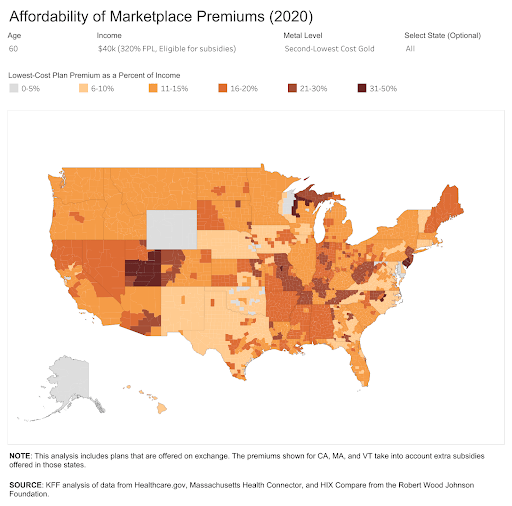Pearl Health believes that understanding the likely path of healthcare reform is critical for providers and payers alike to position themselves for success in the coming years. As such, we examine and summarize the majority party’s healthcare plan in 3 sections: (1) President Biden’s 2020 campaign platform, (2) President Biden’s current stated plans, (3) the ‘Medicare-X’ plan proposed by Senators Michael Bennet (D-CO) and Tim Kaine (D-VA), due to its policy proximity to President Biden’s previous statements and status as the current major healthcare reform bill presented by the Congressional majority.
1.) Candidate Biden’s Campaign Platform
During his 2020 campaign, then-candidate Biden put forward a plan to expand the Affordable Care Act. The main policy initiatives include:
- Creating a ‘Medicare-like’ public option for individuals enrolling on the public healthcare exchanges.
- Expanding the eligibility criteria for tax credits (government subsidies on monthly premiums of exchange plans) to include those making more than 400% of the federal poverty level (FPL)–a population that currently pays full price for individual coverage.
- Indexing tax credits to ‘gold’ plans, rather than ‘silver’ and decreasing the ‘cap’ on income that those buying insurance are expected to pay, from 9.86% to 8.5% of annual income, thereby moving more individuals to plans with richer benefits at lower costs.
In conjunction, the Biden campaign believed these initiatives would reduce costs of health plans by creating downward pressure on gross premiums (rates prior to any government-paid tax credits) via competition from the Medicare-like public option, expand the proportion of the country with health insurance coverage, increase the richness of plan benefits and lower the cost of health coverage for low- and middle-income Americans.

2.) President Biden’s Healthcare Plan
At the time of writing this article, the Biden White House has not yet put forward a major healthcare bill.
Due to the current political climate and distribution of votes in Congress, it is likely that any such major reform would need to pass via Democratic party votes. As such, it would need to be included in a budget reconciliation process, which can be passed via a simple majority vote. The first such use of that process was employed for the Covid relief package. It is expected that the next use of that process will be for President Biden’s proposed infrastructure plan, but many political commentators believe that the third use of the reconciliation process could be applied to healthcare reform.
3.) Medicare-X
Senators Bennet and Kaine recently reintroduced a version of their 2017 Medicare-X Choice Act, which is materially similar to President Biden’s campaign platform. As such, we include it as a likely proxy of what healthcare reform could look like. In summary, Medicare-X would:
- Initially make a Medicare-like public option available to underserved populations with few or no private insurance options on the individual exchange, expanding to all US counties by 2025.
- Expand ACA plan coverage requirements to include free primary care services.
- Expand the premium tax credit (government subsidies of monthly premiums) to all individuals such that no one is spending more than 8.5% of their annual income on health coverage. This rate would be lower for those making less than 400% of the FPL.
- Fix the ‘family glitch’, which prevents individuals from receiving tax credits if a member of their family has access to an ‘affordable health plan’. Currently, affordability is tested on the premium rate for an individual plan. The proposed change would index affordability to the rate of a family plan. The bill’s authors expect that this would lead to as many as 6 million more individuals receiving healthcare coverage.
- Mandate that providers who accept Medicare would also be required to accept Medicare-X, generally at 100% of their Traditional Medicare rates – though the HHS Secretary would have discretion to reimburse providers and hospitals in rural areas up to 150% of Medicare.
- Empower the HHS Secretary to negotiate prescription drug prices directly with pharmaceutical companies for both Medicare-X and Medicare Part D.
It remains to be seen if such a plan will be brought forward during this Congressional term. Pearl will continue to advise its provider and payer clients as new information becomes available.


